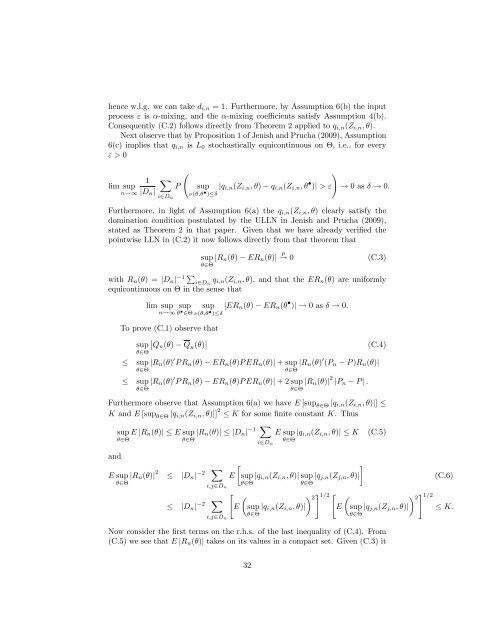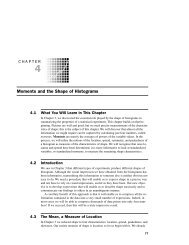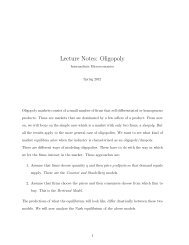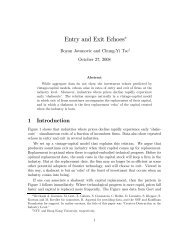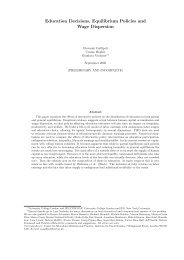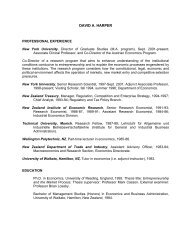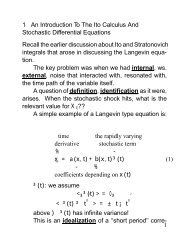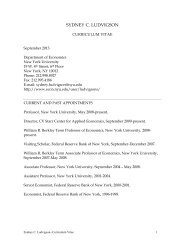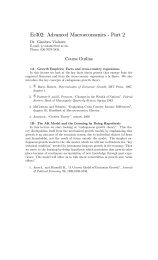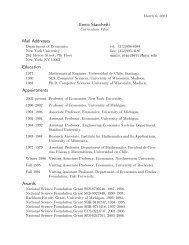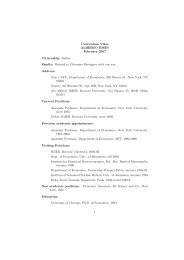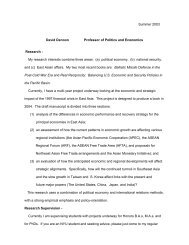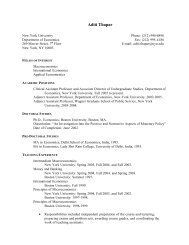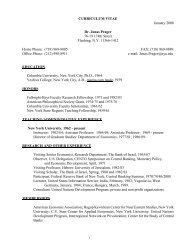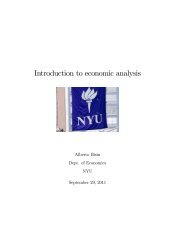On Spatial Processes and Asymptotic Inference under Near$Epoch ...
On Spatial Processes and Asymptotic Inference under Near$Epoch ...
On Spatial Processes and Asymptotic Inference under Near$Epoch ...
You also want an ePaper? Increase the reach of your titles
YUMPU automatically turns print PDFs into web optimized ePapers that Google loves.
hence w.l.g. we can take di;n = 1. Furthermore, by Assumption 6(b) the input<br />
process " is -mixing, <strong>and</strong> the -mixing coe¢ cients satisfy Assumption 4(b).<br />
Consequently (C.2) follows directly from Theorem 2 applied to qi;n(Zi;n; ).<br />
Next observe that by Proposition 1 of Jenish <strong>and</strong> Prucha (2009), Assumption<br />
6(c) implies that qi;n is L0 stochastically equicontinuous on , i.e., for every<br />
" > 0<br />
1<br />
lim sup<br />
n!1 jDnj<br />
X<br />
P<br />
i2Dn<br />
sup<br />
( ; )<br />
jqi;n(Zi;n; ) qi;n(Zi;n; )j > "<br />
!<br />
! 0 as ! 0:<br />
Furthermore, in light of Assumption 6(a) the qi;n(Zi;n; ) clearly satisfy the<br />
domination condition postulated by the ULLN in Jenish <strong>and</strong> Prucha (2009),<br />
stated as Theorem 2 in that paper. Given that we have already veri…ed the<br />
pointwise LLN in (C.2) it now follows directly from that theorem that<br />
1 P<br />
sup jRn( ) ERn( )j<br />
2<br />
p ! 0 (C.3)<br />
with Rn( ) = jDnj i2Dn qi;n(Zi;n; ), <strong>and</strong> that the ERn( ) are uniformly<br />
equicontinuous on in the sense that<br />
lim sup sup<br />
n!1 2<br />
sup<br />
( ; )<br />
To prove (C.1) observe that<br />
sup<br />
2<br />
sup<br />
2<br />
sup<br />
2<br />
jERn( ) ERn( )j ! 0 as ! 0:<br />
Qn( ) Q n( ) (C.4)<br />
jRn( ) 0 P Rn( ) ERn( )P ERn( )j + sup jRn( )<br />
2<br />
0 (Pn P )Rn( )j<br />
jRn( ) 0 P Rn( ) ERn( )P ERn( )j + 2 sup jRn( )j<br />
2<br />
2 jPn P j :<br />
Furthermore observe that Assumption 6(a) we have E [sup 2 jqi;n(Zi;n; )j]<br />
K <strong>and</strong> E [sup 2 jqi;n(Zi;n; )j] 2 K for some …nite constant K. Thus<br />
<strong>and</strong><br />
sup<br />
2<br />
E jRn( )j E sup jRn( )j jDnj<br />
2<br />
E sup jRn( )j<br />
2<br />
2<br />
jDnj<br />
jDnj<br />
2 X<br />
i;j2Dn<br />
2 X<br />
i;j2Dn<br />
E sup<br />
2<br />
"<br />
1 X<br />
i2Dn<br />
E sup jqi;n(Zi;n; )j K (C.5)<br />
2<br />
jqi;n(Zi;n; )j sup jqj;n(Zj;n; )j (C.6)<br />
2<br />
E sup jqi;n(Zi;n; )j<br />
2<br />
2 # 1=2 "<br />
E sup jqj;n(Zj;n; )j<br />
2<br />
Now consider the …rst terms on the r.h.s. of the last inequality of (C.4). From<br />
(C.5) we see that E jRn( )j takes on its values in a compact set. Given (C.3) it<br />
32<br />
2 # 1=2<br />
K:


